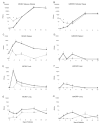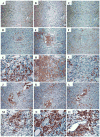A focused salivary gland infection with attenuated MCMV: an animal model with prevention of pathology associated with systemic MCMV infection
- PMID: 17320076
- PMCID: PMC3506192
- DOI: 10.1016/j.yexmp.2006.12.010
A focused salivary gland infection with attenuated MCMV: an animal model with prevention of pathology associated with systemic MCMV infection
Abstract
While the salivary gland has been recognized as an important effector site of the common mucosal immune system, a useful model for studying anti-viral salivary gland immune responses in vivo and for exploring the role of the salivary gland within the common mucosal system has been lacking. Murine cytomegalovirus (MCMV) is a beta-herpesvirus that displays a strong tropism for the salivary gland and produces significant morbidity in susceptible mice when introduced by intraperitoneal (i.p.) inoculation. This study tested the hypothesis that MCMV morbidity and pathology could be reduced by injecting the virus directly the submandibular salivary gland (intraglandular (i.g.)), using either in vivo derived MCMV or the less virulent, tissue-culture-derived MCMV (tcMCMV). Peak salivary gland viral titers were completely unaffected by infection route (i.p vs. i.g.) after inoculation with either MCMV or tcMCMV. However, i.g. tcMCMV inoculation reduced viremia in all systemic tissues tested compared to i.p. inoculation. Furthermore, systemic organ pathology observed in the liver and spleen after i.p. inoculation with either MCMV or tcMCMV was completely eliminated by i.g. inoculation with tcMCMV. Cellular infiltrates in the salivary glands, after i.p. or i.g. inoculation were composed of both B and T cells, indicating the potential for a local immune response to occur in the salivary gland. These results demonstrate that a focused MCMV infection of the salivary gland without systemic organ pathology is possible using i.g. delivery of tcMCMV.
Figures





Similar articles
-
Salivary gland immunization via Wharton's duct activates differential T-cell responses within the salivary gland immune system.FASEB J. 2019 May;33(5):6011-6022. doi: 10.1096/fj.201801993R. Epub 2019 Feb 28. FASEB J. 2019. PMID: 30817215 Free PMC article.
-
Protective MCMV immunity by vaccination of the salivary gland via Wharton's duct: replication-deficient recombinant adenovirus expressing individual MCMV genes elicits protection similar to that of MCMV.FASEB J. 2014 Apr;28(4):1698-710. doi: 10.1096/fj.13-244178. Epub 2014 Jan 3. FASEB J. 2014. PMID: 24391133 Free PMC article.
-
Antibody responses to murine cytomegalovirus in genetically resistant and susceptible strains of mice.J Gen Virol. 1988 Aug;69 ( Pt 8):1987-98. doi: 10.1099/0022-1317-69-8-1987. J Gen Virol. 1988. PMID: 2841411
-
A Review of Murine Cytomegalovirus as a Model for Human Cytomegalovirus Disease-Do Mice Lie?Int J Mol Sci. 2020 Dec 28;22(1):214. doi: 10.3390/ijms22010214. Int J Mol Sci. 2020. PMID: 33379272 Free PMC article. Review.
-
The role of NK cell activity in age-dependent resistance of mice to murine cytomegalovirus infection.Microbiol Immunol. 1985;29(10):939-50. doi: 10.1111/j.1348-0421.1985.tb02958.x. Microbiol Immunol. 1985. PMID: 3001484 Review.
Cited by
-
Washed microbiota transplantation vs. manual fecal microbiota transplantation: clinical findings, animal studies and in vitro screening.Protein Cell. 2020 Apr;11(4):251-266. doi: 10.1007/s13238-019-00684-8. Epub 2020 Jan 9. Protein Cell. 2020. PMID: 31919742 Free PMC article.
-
Small molecule inhibitors of the host cell COX/AREG/EGFR/ERK pathway attenuate cytomegalovirus-induced pathogenesis.Exp Mol Pathol. 2011 Aug;91(1):400-10. doi: 10.1016/j.yexmp.2011.04.014. Epub 2011 May 1. Exp Mol Pathol. 2011. PMID: 21565184 Free PMC article.
-
Salivary gland immunization via Wharton's duct activates differential T-cell responses within the salivary gland immune system.FASEB J. 2019 May;33(5):6011-6022. doi: 10.1096/fj.201801993R. Epub 2019 Feb 28. FASEB J. 2019. PMID: 30817215 Free PMC article.
-
Salivary glands act as mucosal inductive sites via the formation of ectopic germinal centers after site-restricted MCMV infection.FASEB J. 2011 May;25(5):1680-96. doi: 10.1096/fj.10-174656. Epub 2011 Feb 9. FASEB J. 2011. PMID: 21307334 Free PMC article.
-
Preliminary evaluation of a novel serotype O foot-and-mouth disease mRNA vaccine.Front Microbiol. 2025 Apr 28;16:1503191. doi: 10.3389/fmicb.2025.1503191. eCollection 2025. Front Microbiol. 2025. PMID: 40356647 Free PMC article.
References
-
- Allan JE, Shellam GR. Genetic control of murine cytomegalovirus infection: virus titers in resistant and susceptible strains of mice. Arch Virol. 1984;81(1–2):139–150. - PubMed
-
- Bergmeier LA, Tao L, Gearing AJM, Adams S, Lehner T. Induction of IgA and IgG antibodies in vaginal fluid, serum and saliva following immunization of genital and gut associated lymphoid tissue. In: Mestecky J, editor. Advances in Mucosal Immunology. Plenum Press; New York: 1995. pp. 1567–1573. - PubMed
-
- Britt WJ, Alford CA. Cytomegalovirus. In: Fields BN, Knipe DM, Howley PM, editors. Fields Virology. Lippincott-Raven; Philadelphia: 1996. pp. 2493–2523.
-
- Brody AR, Craighead JE. Pathogenesis of pulmonary cytomegalovirus infection in immunosuppressed mice. J Infect Dis. 1974;129(6):677–89. - PubMed
-
- Castellano G, Hazzard, Madden DL, Sever JL. Comparison of the enzyme-linked immunosorbent assay and the indirect hemagglutination test for detection of antibody to cytomegalovirus. J, Infect, Dis. 1977;136:S337–S340. - PubMed
Publication types
MeSH terms
Grants and funding
LinkOut - more resources
Full Text Sources
Other Literature Sources
Medical

